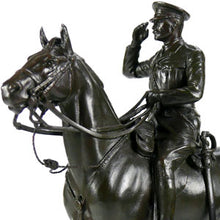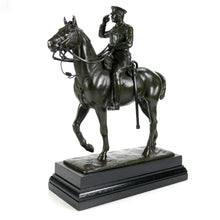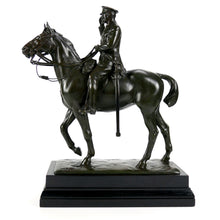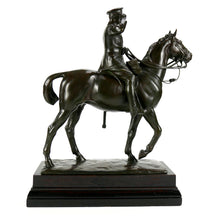Field Marshal Earl Haig Equestrian Figure, 1934
- Regular price
- £8,750
- Sale price
- £8,750
- Regular price
-
- Unit price
- /per
Adding product to your cart
Overall: 42cm (16.5in) x 34cm (13.5in) x 10.5cm (5.2in)
Patinated bronze. Equestrian figure of Field Marshal Douglas Haig, 1st Earl Haig, modelled in field service uniform with right hand raised in salute, riding his horse ‘Poperinghe’. Mounted on shallow naturalistic integral base. Signed and dated, ’S.W. Ward Willis, 1934’. Raised on wood plinth. Height of bronze 36cm (14.2in).
The present figure is a reduction cast taken from a maquette intended as a model for the monumental equestrian statue in Whitehall, London. A newspaper picture of December 1929 shows the sculptor working on the plaster maquette with the caption, ‘Mr Ward Willis, the sculptor, with his model for statue which Lady Haig considers ideal for a memorial to the great soldier.’
Following the Field Marshal’s widely mourned death in 1928, Parliament gave its approval for an equestrian statue to be sited close to the Cenotaph. A national competition for the commission ensued. However, Sir Lionel Earle, the civil servant in charge of the Office of Works, decided there were too many contenders and reduced the final number to just three - Gilbert Ledward, Alfred Hardiman and William Macmillan. A sketch of Hardiman’s winning design appeared in the Times unleashing a storm of controversy that dogged the sculpture up until its final unveiling in 1937. At the heart of the argument, was the horse derived from Hardiman’s studies of Renaissance sculpture. Lady Haig who championed Ward Willis’s model, was particularly critical of the winning design, whilst the British Legion campaigned to have Hardiman paid off and a new competition organised. The furore might explain why Ward Willis’s model was cast in bronze five years after the competition was announced, in the hopes that it might yet supplant Hardiman’s controversial design.
Field Marshal Earl Haig of Bemesyde, KT, OM (1861-1928), Commander British Expeditionary Force on the Western Front from 1915-1918, and commander during the Battles of the Somme, Arras and Ypres, had earlier served in the Mahdist War and the Second Boer War and played a role in the creation of the Territorial Force in 1908. Promoted to Field Marshal in 1917, he led British forces through key campaigns, culminating in the Hundred Days Offensive that contributed significantly to Allied victory in 1918. Modern historians now tend to blame the horrific casualties more on the nature of trench warfare and by the British Army's inherent shortcomings rather than the mistakes of individual commanders. Haig has also been commended for his commitment to the war winning strategy of defeating the Germans on the Western Front. To this end, he oversaw the greatest expansion of the British Army in its history and worked tirelessly to ensure that it evolved into a mighty and sophisticated instrument of war.
Samuel William Ward Willis, FRSBS (1870-1948), was well known for his evocative equine subjects, commemorative works, and his association with the New Sculpture movement. Born in Paddington, London, he was the son of a draper from Southampton. He studied at the West London School of Art and the Royal Academy Schools. His closest friend was the Machine Gun Corps memorial sculptor Francis Derwent Wood. Willis exhibited widely, including nineteen works at the Royal Academy over three decades.










